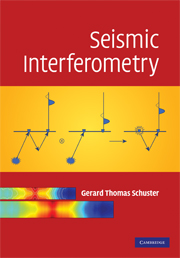Book contents
- Frontmatter
- Contents
- Preface
- 1 Introduction
- 2 Reciprocity equations of convolution and correlation types
- 3 VSP → SWP correlation transform
- 4 VSP → SSP correlation transform
- 5 VSP → SSP convolution transform
- 6 SSP → SSP correlation transform
- 7 VSP → VSP correlation transform
- 8 SSP → VSP → SWP transforms
- 9 Traveltime interferometry
- 10 Stochastic interferometry
- 11 Interferometric source estimation
- 12 Body wave earthquake interferometry
- References
- Index
12 - Body wave earthquake interferometry
Published online by Cambridge University Press: 15 October 2009
- Frontmatter
- Contents
- Preface
- 1 Introduction
- 2 Reciprocity equations of convolution and correlation types
- 3 VSP → SWP correlation transform
- 4 VSP → SSP correlation transform
- 5 VSP → SSP convolution transform
- 6 SSP → SSP correlation transform
- 7 VSP → VSP correlation transform
- 8 SSP → VSP → SWP transforms
- 9 Traveltime interferometry
- 10 Stochastic interferometry
- 11 Interferometric source estimation
- 12 Body wave earthquake interferometry
- References
- Index
Summary
Earthquakes result from deeply buried faults that rupture at different depths and unknown origin times. These factors make earthquakes somewhat analogous to the drill-bit sources used for the SWD example in Chapter 10. Similar to the drillbit example, the VSP→SSP correlation equation can be used to transform the body waves in earthquake data into virtual SSP data; these virtual SSP traces can then be migrated to image the subsurface reflectivity distribution. The frequencies of interest for teleseisms from distant earthquakes are from 0.1–4.0 Hz, so the reconstructed reflectivity model has a spatial resolution that is on the order of kilometers.
To account for the importance of shear waves in earthquake records, the reciprocity equation of correlation type is formulated for the elastic wave equation. It is similar to the acoustic reciprocity equation, except it demands multi-component records of both displacement and traction. Fortunately, simplifications under the far-field approximation allow for its practical application using a formula similar to the acoustic reciprocity equation. Both synthetic and field data are used to validate this methodology, including the imaging of an earthquake data set recorded over a large recording network.
Introduction
Knowing the velocity structure of the crust and mantle is essential for understanding the evolution of continents. Because of their large size, powerful sources such as earthquakes are typically used for large-scale illumination of the Earth's interior. A variety of earthquake imaging methods are available, including traveltime tomography applied to body wave phases (e.g., Aki et al., 1977), surface wave tomography (Nolet, 1987; Gerstoft et al., 2006), receiver function methods (e.g., Langston, 1977, 1979; Dueker and Sheehan, 1998), and body-wave migration (e.g., Mercier et al., 2006; Bostock and Rondenay,…
- Type
- Chapter
- Information
- Seismic Interferometry , pp. 229 - 249Publisher: Cambridge University PressPrint publication year: 2009



